1 Drones Capabilities to Deliver Weapons of Mass Destruction / Disruption (WMDD)
by William Slofer, JR, Wilmington University
Learning goals
- History of drones
- Weaponization of technology
- Various types of drones and their weaponization
Weaponization
Weaponize “: to adapt for use as a weapon of war” (Merriam-Webster, n.d.). Throughout history, humans have become well-practiced in converting everyday devices into instruments of war and doing it with the technology available. We have seen horse-drawn carts, originally used in agriculture and transportation, turned into war chariots; black power, developed in China for medicinal purposes, ironically lives in infamy as the building block for bullets, rockets, artillery, and an endless array of explosive devices with a list of virtually endless bi-products that have been weaponized. As humans continued to make major technological strides through the centuries, there have been colossal leaps that have improved the human condition. Unfortunately, a few individuals in power have always been who would use such advancements to satisfy their greed, lust, and desires to subjugate others. Likewise, through necessity, others have utilized technological advancements to protect and ensure their survival by developing mechanisms or countermeasures to defend against acts of aggression. In the past, the number of people impacted by a particular apparatus was limited in scope by its destructive capabilities and more so by the ability of the assailant(s) to deliver the devices to the desired target. As technology has evolved, so has the want, need, and desire to create better and more efficient weapons and associated delivery systems that can breach or neutralize an opponent’s defenses and perform large-scale attrition of enemy personnel. With numerous advancements in chemistry, medicine, aviation, aerodynamics, and nuclear science, to name a few, it has become possible for an adversary to penetrate almost any defense and eliminate almost every living thing on a continental or global scale.
Any weapon or weapon system’s effectiveness depends on a viable delivery platform. In ancient times, fire weapons were often attached to animals, which became the delivery method to destroy crops or flush out enemies that may be hiding in the brush. Similarly, horses and chariots were a platform to forearm archers with speed and mobility to deliver their deadly arsenal of arrows and spears. Similarly, the small country of Britain became a world power, in large part because it developed a massive well-disciplined, and equipped navy. This navy provided Britain with a superior delivery platform based on ships. Ships allowed for the efficient transport of troops, munitions, and supplies to distant lands. As it continued to improve its technology surrounding cannons and ocean-faring vessels, it gained greater sea superiority via its floating fortresses.
It is important to understand there can and often are differences between weapons and a delivery platform that has been weaponized. This distinction will help explain how things can be repurposed for uses outside their original intent. A sad example that proves this out is commercial airliners. Such aircraft are not built or designed to be a weapon of mass destruction. However, on September 11, 2001, two Boeing 767 jets were highjacked by terrorists and used to crash into New York City’s World Trade Towers, killing an estimated 3,000 people (History.com Editors, 2018). This is an important point from a security perspective because the knowledge, accessibility, and imagination are the only limiting factors. The upcoming chapters will discuss how drones or Unmanned Aerial Vehicles (UAV) have been used in the past and how other technologies are being used as delivery systems or platforms for various types of weapons and weapon systems in the areas of surveillance, chemical, biological, and nuclear warfare, as-well-as other disruptive technologies. The roles they have played and continue playing in weapons delivery and countermeasure advancements.
To obtain a better perspective of drones, it is essential to know that a drone is essentially an unmanned vehicle or device, including robots, that can be remotely controlled, inertially guided, or managed via automatic systems that can be dynamically updated, pre-programmed, or both. It is also important to note that misconceptions should be debunked to appreciate this technology’s possible impact on delivery systems. Although today’s technology is vastly improved, drones are not new, and their use as a delivery platform is certainly not a new concept. If we look through history, it becomes apparent that drones have been used in military applications dating back to an Austrian attack on the besieged city of Venice in1849 with balloons carrying explosives (Holman, 2009). Another of many examples is the use of the V-1 rocket, which was essentially a non-guided cruise missile but still an Unmanned Aerial Vehicle (UAV), deployed by Nazi Germany and starting in June of 1944, rained havoc on Great Britain (Wikipedia, n.d.).
Brief history
Although media attention is given to Unmanned Aerial Vehicles (UAVs), other drone types and delivery platforms should not be overlooked. In addition to UAVs. Remote Operated Vehicles (ROV) and autonomous vehicles are removed from aviation and must be considered when discussing possible delivery systems for Weapons of Mass Destruction/Disruption. Although the below timeline portrays a history of UAVs, its purpose is to show the history of drones as a general category.
Table 1.1
Timeline of drones and their uses
| Year | Activity | Year | Activity |
| 1783 | The first-ever UAV | 1973 | Israel has begun using UAVs for surveillance and scouting purposes. |
| 1849 | Shift to the military use of UAVs | 1985 | The production of drones in the US has increased drastically. |
| 1858 | The first Aerial Photograph with a UAV | 1986 | The introduction of the RQ2 Pioneer Drone |
| 1898 | The first Radio-Controlled craft | 1996 | The introduction of the Predator Drone |
| 1917 | The first UAV, known as the Kettering Bug | 2006 | The US Civilian Airspace used UAVs for the first time. |
| 1935 | The development of the first modern drone | 2010 | Parrot Controls a drone with a Smartphone |
| 1936 | The drone arrived in the US | 2013 | Companies tested drone use as a delivery platform |
| 1937 | The US Navy developed the first radio-controlled UAV | 2014 | The beginning of commercial drone use |
| 1941 | The Radio Plane was invented | 2020 | Drone use for the Covid-19 pandemic |
| 1943 | The Beginnings of First-Person View (FPV) Flight |
Source: (WAcademy Editors, 2021)
Major types of Drones/Robots
As previously mentioned, there on more drone types than aerial, with each having its own set of operational capacities, operating ranges, and capabilities that can be weaponized in a manner to address the theater of use or mission profile:
Aquatic drones
Have some unique characteristics and capabilities not found in air and land-based systems. For example, they must protect their components from water and water under extreme pressures. These devices typically come in two flavors, surface vessels or submersibles.
Surface vessels, also known as Unmanned Surface Vehicles (USV), have a complete range of communications options that could provide near real-time navigation and complete Communication, Command, and Control (C3) facilities for both autonomous semi-autonomous vessel management. Such a device could be used as an explosive delivery system against military or civilian ships. In the wrong hands, a properly outfitted USV, such as the one below, can be a major threat to any surface vessel.
Figure 1.1
Armed Unmanned Surface Vehicle from BAE Systems
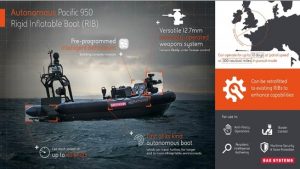
Note: Navy completed trials with this system that can supersede human endurance barriers.
Source: (BAE Systems, 2019)
Tactical USVs of this type could jam ship-to-shore communications and ship-to-ship, leading to increased angst in areas with heightened tensions. On the backdrop of an ocean, the vehicle’s small dimensions provide a level of built-in stealth, giving it the capability to loiter in the ocean undetected for extended periods. It could also be fitted with an aerial system to extend its line of sight, enhancing its ability to detect approaching vessels beyond the horizon to gain an advantage for a sea-based raid or ambush. If performing a hostel act on a civilian vessel, A small USV such as this could cause large destruction and many casualties. The potential occupancy of a Quantum-ultra class cruise vessel with double occupancy would be 4,246 guests and 1,551 crew for 5,797 souls (Thakka, 2022). If there were a 50% mortality rate, approximately 2,900 souls would be lost. It should be noted that the World Trade Towers lost approximately 3,000 people. Alternately, such devices can cause ship-wide chaos and panic. For example, China has reported developing and is ready to deploy a set of high-speed USVs that can intercept, besiege, and expel targeted vessels at sea (Tang, 2021). Such devices circling or simulating an attack on a cruise ship could cause significant chaos and mayhem that the crew may not be able to contain the fear and ensuing panic.
Submergible, or Unmanned Underwater Vehicles (UUV), unlike the USVs, don’t typically have as extensive a range of communication options to obtain and maintain navigational and real-time command and control directives. While submerged, they typically have very limited communications with the surface and therefore have limited or reduced access to satellite or land-based communication aids such as GPS. However, despite such limitations, these vehicles could potentially be the more insidious weapon delivery platform due to their ability to lurk or loiter beneath the water’s surface, awaiting a striking opportunity. The UUV technology can be used as a delivery and recovery platform for weapons created and abandoned by previous generations. A perfect example of this scenario could be retrieving weapons discarded at the bottom of the ocean. From 1918 to 1970, many countries, including the United States, participated in ocean-dumping lethal weapons as a disposal technique. One such example is the intentional sinking of the SS LeBaron Russell Briggs on August 14th, 1970, with a cargo of weapons to be disposed of. Although much of its contents are not published, few details are available. For example, it is reported to have been sunk in 16,000 feet of ocean and was scuttled with “418 steel and concrete coffins in which are embedded twelve and a half thousand rockets containing GB nerve gas, plus one land mine containing the more deadly VX gas whose contents are still top secret.” (Downs, 2017). This is one of many ships lying at the bottom of the ocean with such cargo.
Figure 1.2
Dumpsites of reported chemical and explosive munitions from 1918-to-1980
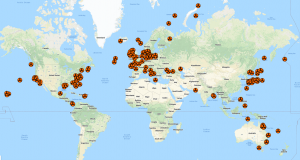
Source: (Wilkinson, 2017)
At the time, many nations considered ocean-dumping of munitions a speedy method of disposal and safe from adversaries because the pressure would crush anything in existence at that time. However, some are bottomed at lesser and others at greater depths. For example, the pressure at 16,000 feet is approximately 7,169 pounds per square inch, and no vehicle at the time would be capable of exploring such depths, let alone perform needed work for extended periods. However, today drones can map the ocean floors at such depths and provide 3d images of any vessel on the ocean bottom. Also, ROVs like the SuBastian can work at depths of 4,500 meters (14,764 feet) and for extended periods (Schmidt Ocean Institute, 2020). The advancements in underwater drone technology have put retrieval of once believed to be deposed weaponry within reach of anyone who may have the means and desire to retrieve them.
Robots/drones
Contrary to popular belief, drones are robots, although many people no longer consider them as such. For discussion, the generic term robots will describe devices other than UAV, USV, and UUV types. Many people have seen robots in such roles as manufacturing, autonomous cars, warehouse transport, and retrieval:
Figure 1.3 Robots – Manufacturing
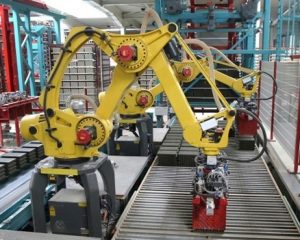
Source: (Rupnar, 2019)
Figure 1.4 Robots – Autonomous Cars

Source: (Safda, 2015)
Figure 1.5 Robots – Warehouse Transport, and Retrieval
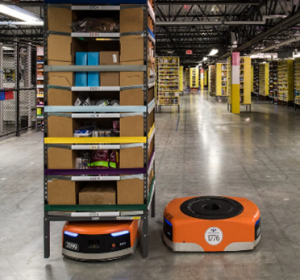
Source: (Wohlsen, 2016)
In addition to these now commonplace robots/drones are those of the humanoid variety. The technological advancements in mechanics, computers, and Artificial Intelligence have transformed what was once science fiction into current-day reality. The military has invested billions of dollars in technology research associated with robotics. The Boston Consulting Group (BCG) has been projecting trend spending, and “In 2014, BCG projected that the market would reach $67 billion by 2025. In 2017, we increased that estimate to $87 billion.” (Wolfgang, Lukic, Sander, Martin, & Kupper, 2017). Some of this funding has been spent with such companies as Boston Dynamics. This engineering and robotics design company has developed its Atlas robotic line to mimic combat soldiers’ performance.
Figure 1.6
DARPA funded Atlas robot developed by Boston Dynamics
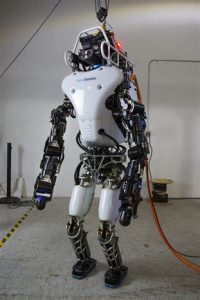
Source: (Ungureanu, 2015)
In the case of an autonomous automobile, it would be very feasible for a terrorist to transport a car bomb via such a delivery method or cause disruption by altering its programming and driving it into a crowd of people in Times Square on New Year’s Eve. In the case of this humanoid robot, an army of these 6’2”, 345-pound (Ungureanu, 2015) devices will make for a formable advisory. In the hands of a bad actor or an opposing force, they could cause mass panic on sight and, if equipped with proper weaponry, could extirpate many people’s lives if unleashed in a populated area.
Unmanned Aerial Vehicle (UAV),
UAV engineering in the 21st century has demonstrated unprecedented capabilities for this technology. UAVs have revolutionized aerial shots in cinematography and become essential in the pipeline and electrical tower inspections, perimeter surveillance, and the list.
Figure 1.7
Aerial drone used in movie scene filming
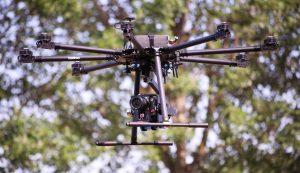
Source: (Italdron, n.d.)
As discussed earlier in the chapter, most tools and technology can be weaponized, which has occurred with drones. Although some have been designed from the bottom-up for war and war-related activities, recreational and commercial drones have been weaponized. A drone does not need to be of a Reaper or Predator classification with the ability to carry 2,000 plus pounds of bombs or Hellfire missiles to be a Weapon of Mass Destruction/Disruption.
Figure 1.8
Image of Predator B drone

Source: (Gupta, 2020)
A smaller device with less complexity and a lower price tag can wreak havoc and massive destruction. For example, small drones have demonstrated the ability to fly in swarms. The capabilities of these swarms have been demonstrated in light shows around the world to celebrate festivals, opening ceremonies, and even July 4th celebrations.
Figure 1.9
Use of synchronized swarming drones in a night display

Source: (Poliak, 2022)
Many drones of respectable quality can be purchased for under $300.00 US. A bad actor could synchronize a small number of these swarming drones to target a passenger aircraft. Flying into the engine intake would cause engine damage and cause an untold large-scale devastation. A similar example of using swarms to create disruption may be a scenario where there is a large gathering, say, the Super Bowl, where a swarm of drones could airdrop pamphlets around the stadium and fly off. The pamphlets could contain a simple printed warning announcing the coming of another swarm carrying a poisonous or explosive payload that will arrive in 10 minutes. Ten minutes later, the appearance of another swarm would most likely cause stadium-wide panic, and some unimaginable number of people would be trampled or crushed to death by the stampede of people attempting to vacate the vicinity. In this case, the mere appearance of the second swarm would be sufficient to cause disruption and death.
Note: R. K. Nichols to W. Slofer (February 18, 2022) Private communication regarding Disinformation dropped from drones. (Nichols, 2022)
As the bazooka and LAW rocket gave individual foot soldiers anti-tank and artillery capabilities, the drone has added aerial support. With drones, a foot soldier can survey an area to determine enemy positions and deliver ordinance to real-time identified targets. This technology has been demonstrated in Ukraine, where soldiers can transport and assemble aerial platforms in the field.
Figure 1.10
Field assembly of a drone capable of thermal imaging and delivery of 1.5kg bombs
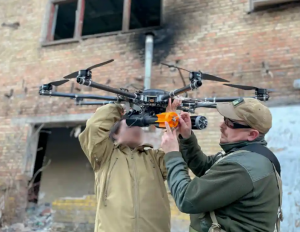
Source: (Borger, 2022)
Or launch a kamikaze drone against tanks or other armored vehicles. With technology such as Switchblade drones, a 2.5kg backpackable drone with a 10km range and the ability to loiter for approximately 15 minutes (Aero Vironment, n.d.), a group of soldiers could hold off a convey. In addition to extending the versability of the soldier, the UAV technology has also armed the civilian population. Reports have shown weaponized adaptations of recreational and commercial drones for explosive delivery.
Figure 1.11
Drones are being used to drop Molotov cocktails against Russian troops in Ukraine.
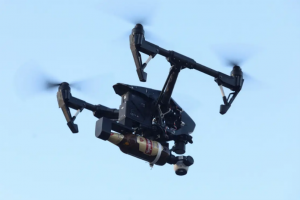
Source: (Kesslen, 2022)
Figure 1.12
DJI drone caring grenade in an improvised carrier made from a plastic jug
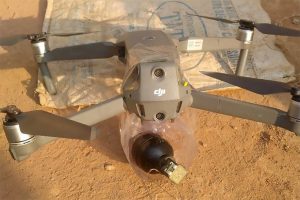
Source: (McCarthy, 2021)
Conclusions
The continued evolution of various disciplines such as chemistry, medicine, construction, engineering, aviation, microprocessors, Artificial Intelligence, and battery technology, amongst others, has allowed humans to heat/cool homes, travel into space, and plant/harvest food in quantities to feed the world. The human race has developed technologies that extend the range of human physical limitations, and the imagination only limits that continued advancement. One outgrowth of this image has been the development of weapon platforms such as drones, robots, and remote or unmanned vehicles that can travel via air, land, or seas and cause destruction without a person on the front line. Also, the creation of weapon systems that can destroy objects from vast distances with a beam of light or high/low-pitched acoustics. Unfortunately, the dark side of this imagination and ingenuity cannot be ignored because, in the wrong hands, it can kill millions with the push of a button. As technology has gotten faster, smaller, and cheaper, there is more of it available for recreational and commercial everyday use. This has made it possible to weaponize things that were not previously conceived of being a weapon or part of a weapon delivery platform. It has also made it possible for bad actors to obtain or create Weapons of Mass Destruction with a simple toolset. Therefore, it is essential to utilize technology as a countermeasure for technology that some individuals or nation-states may abuse. One way to counter such individuals or entities is by understanding the available technologies and those on the horizon and anticipating possible ways they can be weaponized. Such knowledge will provide a basis for developing defenses and countermeasures that can aid in maintaining a balance of power.
BIBLIOGRAPHY
(n.d.). Retrieved from https://nypost.com/2022/03/10/ukrainians-develop-drone-that-drops-molotov-cocktails/
AeroVironment. (n.d.). Switchblade 300. Retrieved from avinc.com: https://www.avinc.com/tms/switchblade
BAE Systems. (2019, July 26). BAE Systems announces evolution in unmanned boat technology. Retrieved from defencetalk.com: https://www.defencetalk.com/bae-systems-announces-evolution-in-unmanned-boat-technology-72410/
Borger, J. (2022, March 8). The drone operators who halted the Russian convoy headed for Kyiv. Retrieved from theguardian.com: https://www.theguardian.com/world/2022/mar/28/the-drone-operators-who-halted-the-russian-armoured-vehicles-heading-for-kyiv
Downs, B. (2017, December 5). 1970. U.S. Scuttles Cargo Ship Full of Nerve Gas Controversy Over the SS LeBaron Russell Briggs. Retrieved from billdownscbs.com: https://www.billdownscbs.com/2017/12/1970-us-scuttles-cargo-ship-full-of.html
Gupta, S. (2020, July 25). The US eases export restrictions on unmanned drones and New Delhi benefits. Retrieved from hindustantimes.com: https://www.hindustantimes.com/world-news/us-eases-export-restrictions-on-unmanned-drones-new-delhi-to-benefit/story-f1GfxnB4e7vKLDvOTRBKwN.html
History.com Editors. (2018, August 25). 9/11 attacks. Retrieved from history.com: https://www.history.com/topics/21st-century/9-11-attacks
Holman, B. (2009, August 22). The first air bomb: Venice, 15 July 1849. Retrieved from airminded.org: https://airminded.org/2009/08/22/the-first-air-bomb-venice-15-july-1849/
Italdron. (n.d.). italdron.com. Retrieved from Aerial Filming: Images that generate emotions: https://www.italdron.com/professional-drones-application/aerial-filming
Kesslen, B. (2022, March 10). Ukrainians develop a drone that drops Molotov cocktails. Retrieved from nypost.com: https://nypost.com/2022/03/10/ukrainians-develop-drone-that-drops-molotov-cocktails/
McCarthy, P. (2021, December 28). Weaponized Drones: The Spread of Commercial-Grade Flying IEDs. Retrieved from offgridweb.com: https://www.offgridweb.com/preparation/weaponized-drones-the-spread-of-commercial-grade-flying-ieds/
Merriam-Webster. (n.d.). Definition of WEAPONIZATION. Retrieved from www.merriam-webster.com: https://www.merriam-webster.com/dictionary/weaponization
Nichols, R. (2022, February 18). R. K. Nichols to W. Slofer (February 18, 2022) Private communication regarding Disinformation dropped from drones. Carlisle, PA, USA: KSU EMAIL.
Poliak, M. (2022). What is a drone light show? Dro0ne display. Retrieved from dronetechplanet.com: https://www.dronetechplanet.com/what-is-drone-light-show-drone-display/
Rupnar, D. (2019, March 26). Small Industrial Robots: What Are The Different Types? Retrieved from techicy.com: https://www.techicy.com/wp-content/uploads/2019/03/Small-industrial-robots_1.jpg
Safda, H. (2015, November 22). Google Self Driving Car Overview and Photo Gallery. Retrieved from Inspirationseek.com: https://inspirationseek.com/wp-content/uploads/2015/11/Google-Self-Driving-Car-Future-Car.jpg
Schmidt Ocean Institute. (2020, April 14). 4500 Meter-Capable Underwater Robotic System Discovers New Species. Retrieved from Roboticsresearch.ch: although some are bottomed at lesser and others deeper depths,
Tang, D. (2021, November 29). China’s drone ships home in on targets at sea2021. Retrieved from thetimes.co.uk: https://www.thetimes.co.uk/article/chinas-drone-ships-home-in-on-targets-at-sea-jsw00swb5
Thakka, E. (2022, January 29). Cruise News Update: January 29, 2022. Retrieved from cruisehive.com: https://www.cruisehive.com/cruise-news-update-january-29-2022/64893
Ungureanu, I. (2015, January 21). Pentagon’s Humanoid Robot Designed for DARPA Challenge Got a Big Update. Retrieved from autoevolution.com: https://s1.cdn.autoevolution.com/images/news/pentagons-humanoid-robot-designed-for-darpa-challenge-got-a-big-update-video-91386_1.jpg
WAcademy Editors. (2021, October 19). Drone Timeline: An Overview of the History of Drones. Retrieved from academy.wedio.com: https://academy.wedio.com/history-of-drones/
Wikipedia. (n.d.). V-1 flying bomb. Retrieved from wikipedia.org: https://en.wikipedia.org/wiki/V-1_flying_bomb
Wilkinson, I. (2017, August 1). Chemical weapons material dumped at sea: An interactive map. Retrieved April 6, 2022, from nonproliferation.org: https://nonproliferation.org/chemical-weapon-munitions-dumped-at-sea/
Wohlsen, M. (2016, December 14). Amazon Reveals the Robots at the Heart of Its Epic Cyber Monday Operation. Retrieved from Wired.com: https://media.wired.com/photos/593232485c4fbd732b55127a/master/w_1600,c_limit/dk_113014-301.jpg
Wolfgang, M., Lukic, V., Sander, A., Martin, J., & Kupper, D. (2017, June 14). Gaining Robotics Advantage. Retrieved from bcg.com: https://www.bcg.com/publications/2017/strategy-technology-digital-gaining-robotics-advantage

